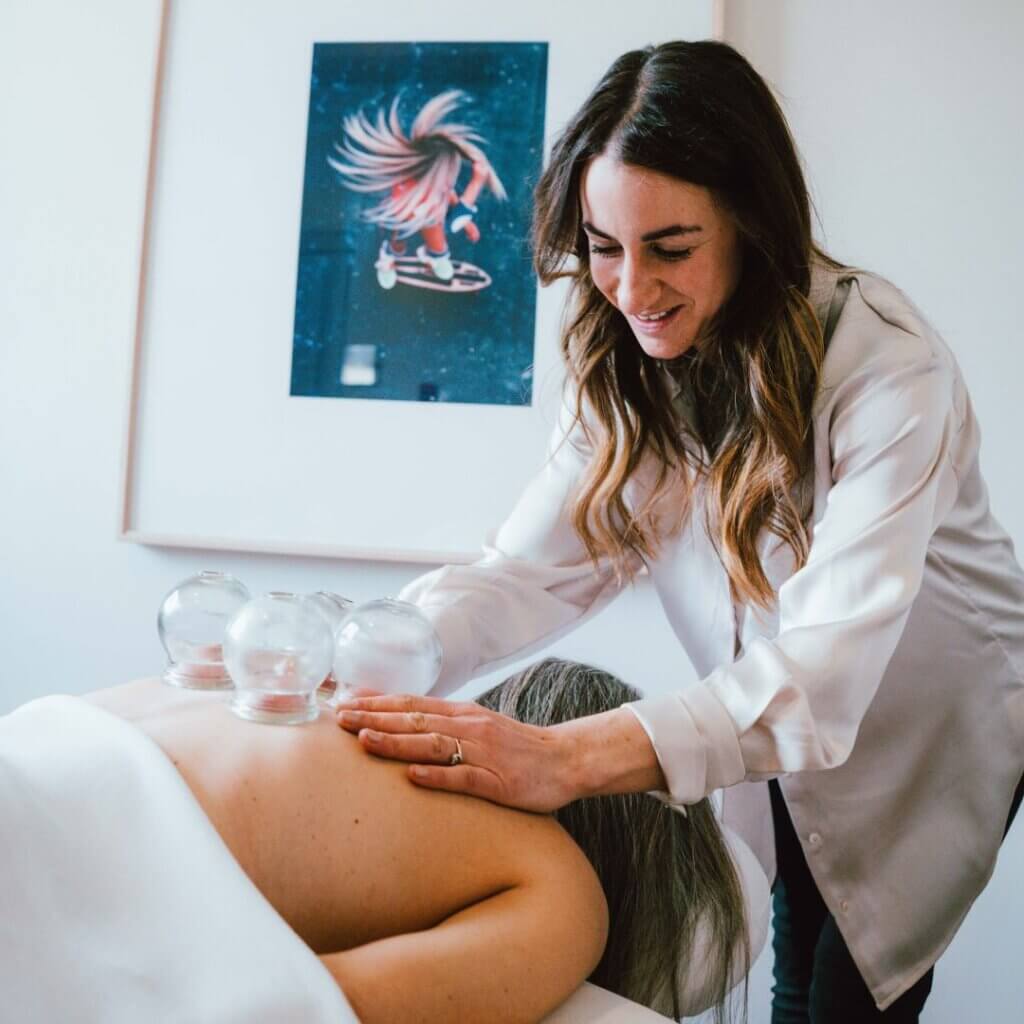
Cupping

Cupping has gained popularity as an effective addition to acupuncture & massage therapy treatments. It involves the use of specialized cups that create suction on the skin, offering a unique and therapeutic experience.
What is Cupping?
Cupping is an ancient practice that originated in traditional Chinese medicine. It involves placing specially designed cups on the skin, creating a vacuum effect. The cups can be made of various materials such as glass or silicone. The suction created by the cups draws the skin and underlying tissues upward, stimulating blood flow and promoting healing.
How does Cupping help?
Improved Blood Circulation: Cupping helps to improve blood circulation by drawing stagnant blood and toxins to the surface. The suction created by the cups expands blood vessels and capillaries, allowing fresh oxygenated blood to nourish the tissues. This increased circulation aids in removing metabolic waste, reducing inflammation, and promoting faster healing.
Muscle Relaxation and Tension Relief: Cupping therapy targets deep layers of muscle tissue, providing a unique form of deep tissue massage. The suction created by the cups helps to release tension and adhesions within the muscles. As the cups glide over the skin, they create a gentle pulling sensation, helping to loosen tight muscles and improve flexibility. This can be particularly beneficial for individuals suffering from chronic muscle pain or sports-related injuries.
Detoxification: Cupping facilitates the release of toxins from the body. As the suction draws toxins and waste products to the surface, the lymphatic system is stimulated, encouraging the elimination of these substances. This detoxification process can leave you feeling revitalized, as the body is able to remove harmful substances more efficiently.
Stress Reduction and Relaxation: Like traditional massage therapy, cupping induces a state of deep relaxation. The cups create a unique sensation on the skin, promoting a sense of calm and tranquility. The treatment can also activate the parasympathetic nervous system, which helps to counteract the effects of stress, reduce anxiety, and improve overall well-being.
What to Expect with Cupping:
During a cupping massage session, a registered therapist will assess your specific needs and determine the most appropriate technique and cupping method. The therapist will typically apply massage oil to your skin before placing the cups. The cups may be left in one place or moved in a gliding motion over the skin, depending on the desired outcome.
It’s important to note that cupping can leave temporary marks on the skin. These marks are typically circular and vary in color from light pink to deep purple. They are not bruises but rather a result of the suction drawing stagnant blood and toxins to the surface. The marks usually fade within a few days, and they are not painful.
What is the difference between Silicone Cupping & Fire Cupping?
Silicone Cupping:
Silicone cups are made from medical-grade silicone Silicone cups come in various sizes and can be easily manipulated to fit different body parts. Gentle and Controlled: Silicone cupping provides a gentler suction compared to fire cupping. The level of suction can be adjusted by pressing the cups onto the skin and releasing the air. This allows for a more controlled and customizable treatment, particularly for individuals with sensitive skin or a low pain tolerance. They can be easily moved or glided over the skin, providing a massage-like experience.
Fire Cupping:
Fire cupping is a traditional form of cupping that involves the use of glass or bamboo cups. The cups are heated with fire, which removes the oxygen inside, and then placed onto the skin, creating a vacuum effect. As the air cools down, it creates suction and pulls the skin and underlying tissues into the cup
Strong Suction: Fire cupping generates a stronger suction compared to silicone cupping. The intensity of the suction is determined by the amount of heat applied and the skill of the practitioner.
Traditional Cupping: Fire cupping has a long-standing history and is deeply rooted in traditional medicine practices, particularly in Chinese and Middle Eastern cultures.
Experienced Practitioner Required: Due to the use of fire and the potential risks involved, fire cupping is only performed by a trained and experienced therapist. Our therapists must have a thorough understanding of the technique, appropriate flame control, and safety measures.
How to Book:
All of our Massage Therapists offer cupping as part of their treatments. Cupping is not a separate treatment; it can be included in any massage or not, depending on your preference. If you’d like to learn more about the specific styles of cupping available, please contact us at info@backatitwellness.com, and we will be happy to provide more information. If you’re interested in cupping, please bring it up at the start of your treatment with your therapist.
Our acupuncturists also incorporate Fire Cupping into their treatments when they determine it is a good fit for your needs. You can request Fire Cupping during your appointment, this is a discussion to be had at the beginning of your session with your therapist or acupuncturist.







Leave a Reply